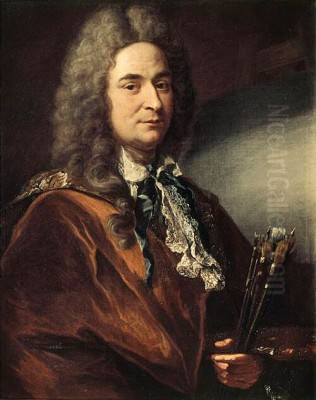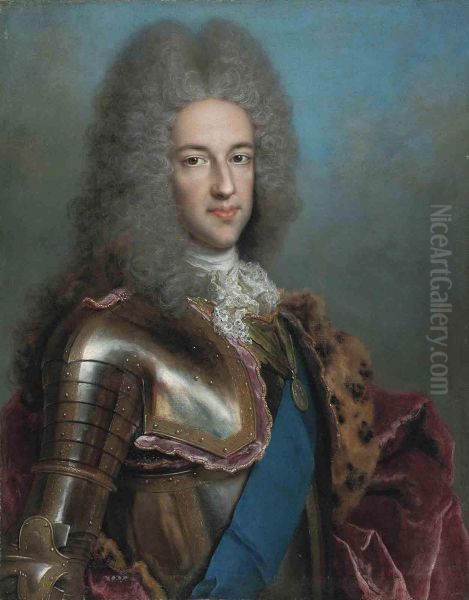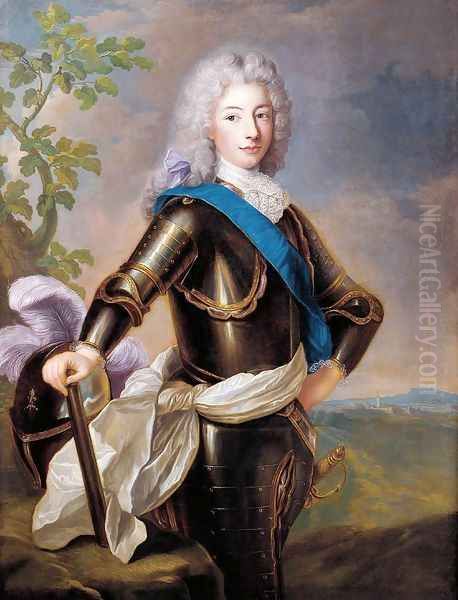
Alexis Simon Belle (1674–1734) stands as a significant, if sometimes overlooked, figure in the rich tapestry of French art during the late Baroque and early Rococo periods. A Parisian by birth and death, Belle carved a distinguished career as a portrait painter, his brush capturing the likenesses of French and European nobility with a characteristic elegance and precision. His work, deeply rooted in the classical tradition, provides a fascinating window into the aristocratic societies of the early 18th century, a time of shifting tastes and political currents. Active primarily during what is often termed the Classical period in French art, his career bridged the formal grandeur of Louis XIV's reign with the burgeoning, more intimate style that would flourish later in the century.
Early Life and Artistic Formation in Paris
Born in Paris in 1674, Alexis Simon Belle emerged into an artistic world dominated by the Académie Royale de Peinture et de Sculpture, which dictated artistic standards and provided the primary route to official recognition and patronage. The young Belle's artistic inclinations led him to the studio of François de Troy (1645–1730), a highly respected portraitist and history painter. De Troy was himself a pivotal figure, known for his elegant and refined portraits that often flattered his sitters while maintaining a strong sense of character. Under de Troy's tutelage, Belle would have absorbed the fundamental principles of French classical portraiture: meticulous draftsmanship, harmonious composition, a rich but controlled palette, and the ability to convey the sitter's status and personality.

The artistic environment of Paris at this time was vibrant. While the grand manner of Charles Le Brun (1619–1690) still cast a long shadow from the previous generation, new talents were emerging. Belle's training placed him in a lineage of accomplished portraitists. His master, François de Troy, was a contemporary of artists like Pierre Mignard (1612–1695), who had succeeded Le Brun as Premier peintre du Roi. Furthermore, Belle's development occurred alongside, and was undoubtedly influenced by, two other towering figures in French portraiture: Hyacinthe Rigaud (1659–1743) and Nicolas de Largillière (1656–1746). Although the provided information lists Rigaud and Largillière as "teachers," it is more accurate to consider them as highly influential senior contemporaries whose work set the benchmark for excellence. Belle certainly studied their techniques and artistic solutions, learning from their mastery of texture, their dramatic use of light and shadow, and their ability to imbue portraits with a sense of majesty and psychological depth.
The Influence of Masters and Contemporaries
François de Troy's influence on Belle was foundational. De Troy was celebrated for his group portraits and his sensitive portrayals of women and children, often characterized by a softer, more graceful approach than the more overtly heroic style of Rigaud. Belle inherited de Troy's commitment to elegance and a certain refined naturalism. He learned how to manage complex compositions, render luxurious fabrics with convincing detail, and capture the subtle nuances of expression.
Hyacinthe Rigaud, renowned for his state portraits, particularly his iconic depiction of Louis XIV, offered a model of how to convey power and authority through pose, costume, and setting. Rigaud's work was marked by its opulence, its dynamic compositions, and its rich, vibrant color. While Belle's palette might be described as somewhat more restrained than Rigaud's, the older master's influence can be seen in Belle's more formal portraits, where the emphasis is on the sitter's public persona and social standing.
Nicolas de Largillière, on the other hand, was known for his versatility, excelling in portraits of the wealthy bourgeoisie as well as the aristocracy. His style was often characterized by a greater warmth and vivacity, a Flemish richness in color and texture, and a remarkable ability to capture a sense of movement and immediacy. Belle would have observed Largillière's skill in creating lively and engaging likenesses, particularly in less formal contexts.
The artistic landscape also included other notable painters. Jean Jouvenet (1644–1717) was a prominent history painter whose religious and mythological scenes adorned many churches and public buildings. In portraiture, figures like Jean-Baptiste Santerre (1651–1717) and Robert Le Vrac de Tournières (1667–1752) were also active, each contributing to the evolving styles of the period. Belle's artistic development was thus shaped not only by direct instruction but also by the broader artistic currents and the high standards set by these accomplished contemporaries.
Forging an Independent Style: Classical Principles with Personal Nuance

Having completed his training, Alexis Simon Belle established himself as an independent master. He was received into the prestigious Académie Royale de Peinture et de Sculpture in 1703, a testament to his skill and a crucial step for securing important commissions. His reception piece was likely a portrait demonstrating his mastery of the required conventions.
Belle’s style, while firmly within the classical tradition, developed its own distinct characteristics. He adhered to the classical emphasis on clarity, balance, and idealized representation, yet his works often possess a subtle intimacy and a keen observation of individual character. His compositions are typically elegant and well-structured, with figures often posed against simple backgrounds or within tastefully appointed interiors that suggest their status without overwhelming them.
A hallmark of Belle's work is his meticulous attention to detail, particularly in the rendering of fabrics – silks, velvets, lace, and ermine are depicted with a tactile realism that speaks to the luxury of his sitters' attire. This careful rendering of costume was not merely decorative; it was an essential component of portraiture in this era, signifying wealth, rank, and fashion. His brushwork is generally smooth and refined, contributing to the overall sense of polish and sophistication.
Compared to Rigaud, Belle's coloration could be seen as less overtly brilliant, perhaps more harmonious and subtly modulated. While Rigaud often employed dramatic contrasts and a richer, more saturated palette, Belle favored a more balanced approach, achieving an effect of dignified restraint. In terms of composition, some art historians have noted that Belle's arrangements could be more "rigorous" or formal than those of Largillière, who often introduced more dynamic or informal elements. Belle's figures often possess a certain "distant and calm character," a composed demeanor that reflects the decorum expected of the aristocracy.
Key Patrons and Representative Works
Alexis Simon Belle enjoyed a successful career, attracting patronage from the French aristocracy and, significantly, from the exiled Jacobite court. His ability to convey both status and a degree of personal charm made him a sought-after portraitist.
One of his most famous works is the _Portrait of Antoine Crozat_ (circa 1710-1715). Antoine Crozat, Marquis du Châtel, was an immensely wealthy financier and art collector, one of the "nouveaux riches" who played an increasingly important role in French society. Belle depicts Crozat with an air of confident authority, surrounded by symbols of his wealth and taste. The painting showcases Belle's skill in rendering textures and capturing a strong likeness, reflecting the sitter's significant social and economic standing.
Another notable commission was the _Portrait of Louise Hippolyte Grimaldi, Princess of Monaco_ (circa 1710s-1720s). This work, like many of his female portraits, emphasizes elegance and grace. The depiction of the Princess would have required a delicate balance between conveying her royal status and her personal charm. It is in relation to a portrait of a Grimaldi princess (possibly this one, or another) that a minor contemporary critique is sometimes mentioned, suggesting that the blue in the drapery was perhaps "too brightly" rendered for some tastes, highlighting the nuanced discussions around color and harmony prevalent at the time.
Belle also received commissions from the French royal family. He painted portraits of the young Louis XV and his Polish-born queen, Maria Leszczyńska. These royal commissions were of paramount importance, cementing an artist's reputation and leading to further opportunities. His portrait of _Stanisław I Leszczyński, King of Poland and Duke of Lorraine and Bar_ (father of Queen Maria Leszczyńska), further demonstrates his connection to European royalty. Another work, titled _Marie-Anne-Victoire_, likely refers to Marie Anne Victoire of Bavaria, Dauphine of France.
The _Portrait of a Nun_, now housed at Wynnstay in the United Kingdom, shows a different facet of his work. While still a portrait, the subject matter and context would have called for a more subdued and introspective treatment, showcasing Belle's versatility in adapting his style to the sitter's persona and role.
His works are found in prestigious collections, including the Palace of Versailles and the Musée de Tessé in Le Mans, which holds a significant collection of French paintings. These institutions preserve his contribution to the visual record of early 18th-century French society.
The Painter of the Exiled Stuart Court
A particularly fascinating aspect of Belle's career was his role as a favored painter for the Jacobite court, the exiled Stuarts and their followers who resided in Saint-Germain-en-Laye, near Paris, after the Glorious Revolution of 1688. James II of England (VII of Scotland) was granted asylum by Louis XIV, and his son, James Francis Edward Stuart (the "Old Pretender"), and grandson, Charles Edward Stuart ("Bonnie Prince Charlie" or the "Young Pretender"), maintained a court in exile.
Belle produced numerous portraits of members of this exiled aristocracy. These portraits served an important political purpose, maintaining the visual presence of the Stuarts and their claim to the British thrones. For the Jacobites, these images were symbols of legitimacy and hope for a restoration. Belle's portraits of figures such as James Francis Edward Stuart and his wife, Maria Clementina Sobieska, were crucial in projecting an image of a dignified and rightful royal family. He also painted many of their prominent supporters. This sustained patronage from the Jacobites provided Belle with a steady stream of commissions and a unique niche in the Parisian art world. His ability to capture both the melancholy dignity of exile and the enduring assertion of royal status resonated with his Jacobite sitters.
Academic Recognition, Later Career, and Legacy
Alexis Simon Belle's career was marked by official recognition. His membership in the Académie Royale de Peinture et de Sculpture from 1703 onwards allowed him to exhibit regularly at the Paris Salon, the official art exhibition that was a critical venue for artists to display their work and attract patrons. Participation in the Salon was essential for maintaining visibility and prestige.
Throughout his career, Belle remained a consistent practitioner of the classical portrait style, adapting subtly to evolving tastes but never fully embracing the lighter, more overtly decorative Rococo style that gained prominence with artists like Jean-Antoine Watteau (1684–1721), François Boucher (1703–1770), and later, Jean-Honoré Fragonard (1732–1806). While Watteau was revolutionizing genre painting with his fêtes galantes, and younger portraitists like Jean-Marc Nattier (1685–1766) were beginning to develop a more mythological and allegorical style of portraiture, Belle continued to provide the dignified and elegant likenesses that his clientele desired.
He also played a role in educating the next generation of artists. One of his notable students was Jacques-André-Joseph-Camelot Aved (1702–1766), who himself became a distinguished portrait painter, known for his more naturalistic and psychologically penetrating portraits, perhaps reflecting a shift in taste towards the mid-18th century.
Alexis Simon Belle continued to work productively until his death in Paris in 1734. He left behind a substantial body of work that documents the faces and fashions of an era. While perhaps not as innovative as some of his contemporaries, his contribution lies in his consistent quality, his refined technique, and his role as a chronicler of a specific social and political milieu. His paintings reflect the values of his time: an appreciation for elegance, order, and the clear articulation of social status. He successfully navigated the competitive art world of Paris, securing prestigious commissions and maintaining a respected position among his peers, such as Charles-Antoine Coypel (1694–1752), who was active in history painting and portraiture, and Jean-Baptiste Oudry (1686–1755), known for his animal paintings and still lifes but also a capable portraitist.
Conclusion: An Enduring Contribution to Portraiture
Alexis Simon Belle was a quintessential portraitist of his age, a master of his craft whose career flourished in the sophisticated artistic environment of early 18th-century Paris. Trained in the classical tradition by François de Troy and keenly aware of the achievements of giants like Rigaud and Largillière, he forged a style characterized by elegance, precision, and a dignified representation of his sitters. His extensive work for both the French aristocracy and the exiled Jacobite court provides invaluable historical and cultural insights.
While the Rococo movement would soon bring new artistic sensibilities to the fore, Belle's adherence to classical principles, combined with his sensitivity to character and his meticulous technique, ensured his success and lasting reputation. His portraits remain compelling testaments to the individuals who shaped the political and social landscape of early 18th-century Europe, captured with the skill and artistry of a dedicated and accomplished painter. His legacy is preserved not only in the numerous canvases that bear his name but also in his contribution to the continuity of the French tradition of formal portraiture.